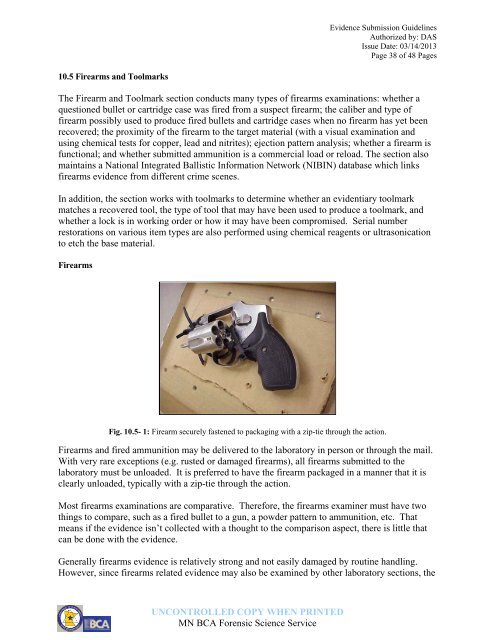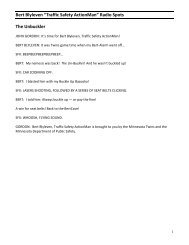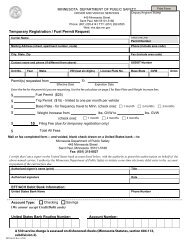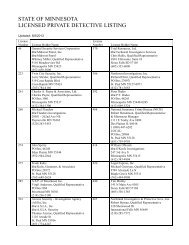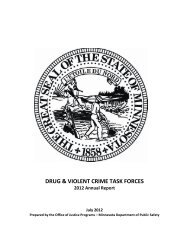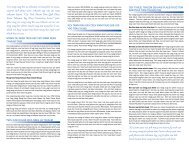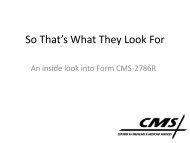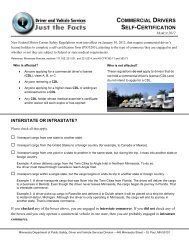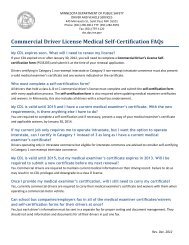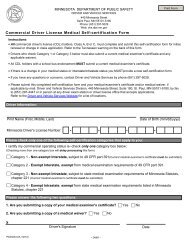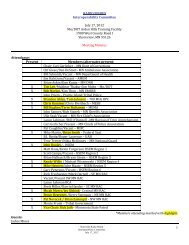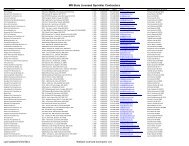Evidence Submission Guidelines - Minnesota Department of Public ...
Evidence Submission Guidelines - Minnesota Department of Public ...
Evidence Submission Guidelines - Minnesota Department of Public ...
Create successful ePaper yourself
Turn your PDF publications into a flip-book with our unique Google optimized e-Paper software.
10.5 Firearms and Toolmarks<br />
UNCONTROLLED COPY WHEN PRINTED<br />
MN BCA Forensic Science Service<br />
<strong>Evidence</strong> <strong>Submission</strong> <strong>Guidelines</strong><br />
Authorized by: DAS<br />
Issue Date: 03/14/2013<br />
Page 38 <strong>of</strong> 48 Pages<br />
The Firearm and Toolmark section conducts many types <strong>of</strong> firearms examinations: whether a<br />
questioned bullet or cartridge case was fired from a suspect firearm; the caliber and type <strong>of</strong><br />
firearm possibly used to produce fired bullets and cartridge cases when no firearm has yet been<br />
recovered; the proximity <strong>of</strong> the firearm to the target material (with a visual examination and<br />
using chemical tests for copper, lead and nitrites); ejection pattern analysis; whether a firearm is<br />
functional; and whether submitted ammunition is a commercial load or reload. The section also<br />
maintains a National Integrated Ballistic Information Network (NIBIN) database which links<br />
firearms evidence from different crime scenes.<br />
In addition, the section works with toolmarks to determine whether an evidentiary toolmark<br />
matches a recovered tool, the type <strong>of</strong> tool that may have been used to produce a toolmark, and<br />
whether a lock is in working order or how it may have been compromised. Serial number<br />
restorations on various item types are also performed using chemical reagents or ultrasonication<br />
to etch the base material.<br />
Firearms<br />
Fig. 10.5- 1: Firearm securely fastened to packaging with a zip-tie through the action.<br />
Firearms and fired ammunition may be delivered to the laboratory in person or through the mail.<br />
With very rare exceptions (e.g. rusted or damaged firearms), all firearms submitted to the<br />
laboratory must be unloaded. It is preferred to have the firearm packaged in a manner that it is<br />
clearly unloaded, typically with a zip-tie through the action.<br />
Most firearms examinations are comparative. Therefore, the firearms examiner must have two<br />
things to compare, such as a fired bullet to a gun, a powder pattern to ammunition, etc. That<br />
means if the evidence isn’t collected with a thought to the comparison aspect, there is little that<br />
can be done with the evidence.<br />
Generally firearms evidence is relatively strong and not easily damaged by routine handling.<br />
However, since firearms related evidence may also be examined by other laboratory sections, the


